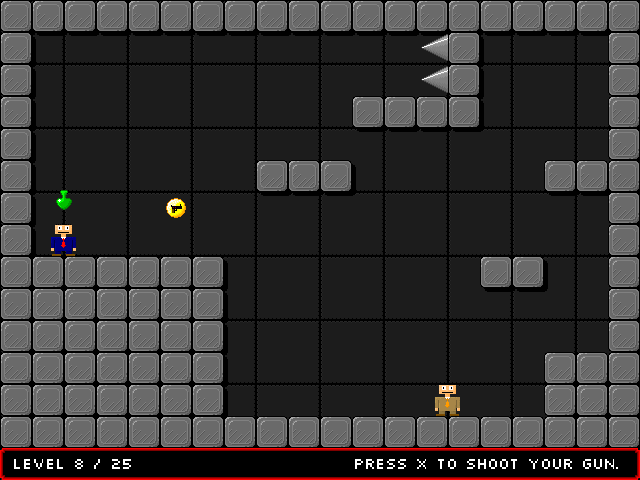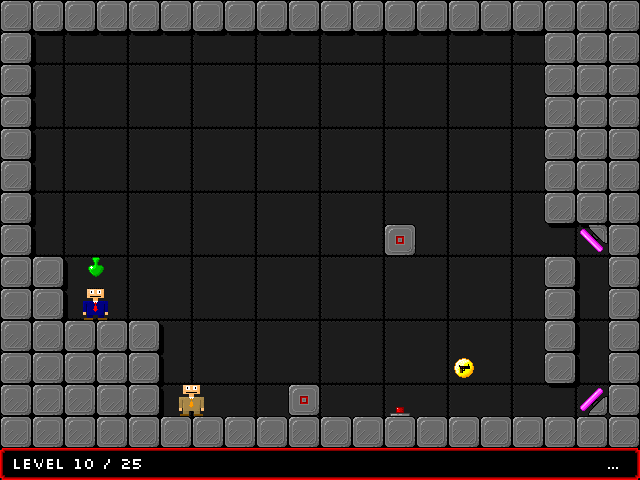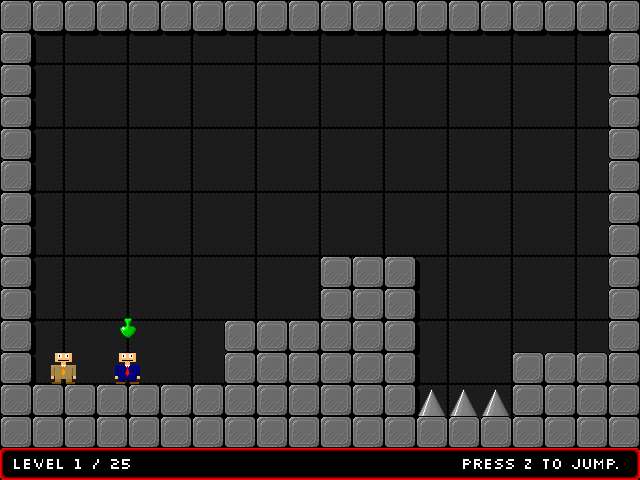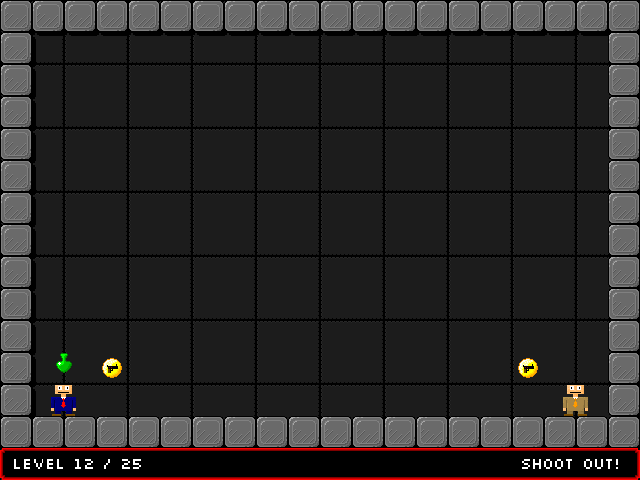Retro Replay Review
Gameplay
Karoshi Factory shifts the series’ trademark suicide-as-victory mechanic into a purely logic-driven puzzle platformer. Across 25 self-contained levels, your sole objective is to get your characters killed, but unlike its predecessors, you won’t rely on bizarre physics exploits or surreal glitches. Instead, you must manipulate buttons, push boxes, fire a gun against bumpers and hazards, and time each move precisely to engineer your own demise.
Most stages feature two little salarymen whom you control by switching the focus back and forth. You might need to trigger a switch with one character while the other positions a box just right, or fire a bullet from your gun to knock a bumper into place. Later puzzles introduce a third character, exponentially expanding the range of interactions and requiring more elaborate coordination. The learning curve is steady: early levels ease you into the switching mechanic, while later stages combine timing windows of mere frames with intricate multi-step sequences.
The level design strikes a fine balance between cleverness and fairness. Every element—movable crates, timed doors, spring bumpers—serves a clear purpose, and you rarely feel punished by unpredictable physics. Instead, failure stems from miscalculations or missed timing cues, which encourages you to refine your strategy. Checkpoints are well placed, so even in the trickier multi-character puzzles, you can iterate without retracing half the stage.
What elevates Karoshi Factory’s gameplay is the satisfaction of pulling off a well-orchestrated self-destruct. When each piece falls perfectly into place—switches flipped, boxes stacked, bullets ricocheting—your protagonists meet their end in a dazzling chain reaction. It’s a darkly humorous payoff that feels earned, rather than arbitrary. If you relish brainteasers that demand both logical foresight and split-second timing, this game will keep you hooked through all 25 levels.
Graphics
Though Karoshi Factory doesn’t aim for photorealism, its visual design is crisp, colorful and instantly readable. The minimalist 2D sprites for your characters and interactive objects pop against the subdued backgrounds, ensuring you can always track moving parts and spot crucial details at a glance. The entire presentation feels polished despite its retro-inspired simplicity.
Animations are smooth and purposeful. Whether it’s a box gliding across a conveyor belt or your salaryman taking his final leap into a sawblade, each motion carries weight and clarity. Subtle visual cues—like a button slightly depressing when primed or a bumper flashing before releasing—help reinforce the game’s logical ruleset so you can predict and plan with confidence.
The level aesthetics evolve as you progress, introducing new color schemes and hazard designs to keep the experience fresh. Industrial backdrops give way to more precarious arenas, each with its own visual identity. This variety complements the ever-increasing puzzle complexity, reinforcing the sensation that you’re venturing deeper into the factory’s mysterious machinery.
Backgrounds remain unobtrusive, serving more as atmospheric dressing than narrative vehicles. This intentional design choice keeps your focus firmly on the puzzle elements. Overall, Karoshi Factory’s graphics succeed by marrying functional clarity with a playful, almost cartoony style that meshes perfectly with its dark comedic tone.
Story
Karoshi Factory offers virtually no traditional storyline, instead relying on the series’ signature premise: your tiny salarymen are desperate enough to embrace any death trap you can devise. There’s no overarching plot or dialogue, just a succession of cleverly constructed scenarios where your job is to engineer their demise. It’s absurd, it’s morbid, and it’s endlessly entertaining.
The game’s dark humor emerges purely from its premise and level design. Each puzzle feels like a macabre Rube Goldberg machine with your characters cast as both the engineer and the unwitting victim. There’s a tongue-in-cheek consistency to the world: suits, ties, briefcases and office signage pepper the levels, subtly reinforcing the notion that these poor souls will do anything to escape the daily grind.
What little narrative cohesion exists comes from the escalating complexity of the factory itself. As you unlock subsequent levels, the environments feel more industrial and treacherous, hinting at a deeper conspiracy behind the assembly-line horrors. But these are only whispered suggestions—you’re free to imagine any backstory that fits your own macabre sense of humor.
In the end, Story in Karoshi Factory is purely thematic. It sets the tone for a puzzle game that blends suicidal glee with razor-sharp design. If you go in expecting character development or plot twists, you’ll be disappointed; but if you embrace the game’s philosophical joke—that your best achievement is a self-inflicted demise—you’ll find a uniquely darkly comedic experience.
Overall Experience
Karoshi Factory delivers exactly what it promises: 25 fiendishly clever puzzles that blend logical reasoning with split-second timing. Each completed stage brings a rush of dark satisfaction as you watch your characters meet their ends in increasingly elaborate ways. The game’s bite-sized levels make it easy to play in short bursts, yet the slow build of challenge keeps you coming back for more.
While the difficulty can spike sharply in later levels, the inclusion of generous checkpoints and the ability to restart instantly means frustration never becomes overwhelming. You learn to think several moves ahead and to anticipate environmental reactions, turning each failure into a valuable lesson rather than a punitive setback. This design philosophy keeps the flow steady and the player engaged.
Replay value stems from the pure satisfaction of mastery. Even after you solve a puzzle, you might revisit it to discover alternate kill paths or to shave precious seconds off your best time. Though there’s no online leaderboard, the self-driven pursuit of perfection gives the game an enduring undercurrent of competitiveness—against the clock and against your own previous runs.
For fans of minimalist puzzle platformers who appreciate dark humor and don’t mind a challenge, Karoshi Factory is an irresistible package. It refines the series’ core concept with sharper logic puzzles, seamless controls and a visual style that highlights clarity. If you’re looking for a fresh take on brain-teasing platformers and won’t shy away from guiding your characters to their doom, this factory is open for business.
 Retro Replay Retro Replay gaming reviews, news, emulation, geek stuff and more!
Retro Replay Retro Replay gaming reviews, news, emulation, geek stuff and more!









Reviews
There are no reviews yet.